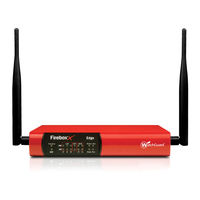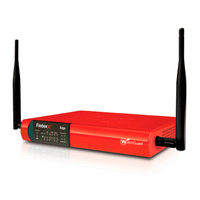Watchguard Firebox X Edge e-Series Manuals
Manuals and User Guides for Watchguard Firebox X Edge e-Series. We have 2 Watchguard Firebox X Edge e-Series manuals available for free PDF download: User Manual
Watchguard Firebox X Edge e-Series User Manual (310 pages)
Firebox X Edge e-Series version 10 All Firebox X Edge e-Series Standard and Wireless Models
Brand: Watchguard
|
Category: Gateway
|
Size: 10.29 MB
Table of Contents
-
-
-
About Ports18
-
-
-
-
-
-
Logging Page40
-
VPN Page44
-
Wizards Page44
-
-
ARP Table45
-
Connections46
-
DHCP Leases47
-
Disk Usage47
-
Dynamic DNS48
-
Interfaces48
-
License49
-
Livesecurity49
-
Memory49
-
Processes49
-
Protocols50
-
Routes50
-
Syslog50
-
-
-
-
-
Setup Wizard78
-
-
-
-
WAN Failover105
-
Multi-WAN105
-
-
-
-
-
Policy Rules128
-
-
-
-
-
Settings Tab163
-
Content Tab163
-
-
-
-
-
High Priority178
-
Medium Priority178
-
Low Priority178
-
Traffic Marking179
-
-
-
-
-
About Webblocker219
-
-
-
-
-
-
-
-
-
Phase 1 Settings270
-
Phase 2 Settings273
-
-
-
-
-
Before You Begin301
Advertisement
Watchguard Firebox X Edge e-Series User Manual (310 pages)
Firmware Version 8.6 All Firebox X Edge e-Series Standard and Wireless Models
Brand: Watchguard
|
Category: Gateway
|
Size: 3.57 MB
Table of Contents
-
-
Protocols14
-
IP Addresses15
-
About DHCP16
-
About Pppoe16
-
Ports17
-
Firewalls18
-
-
3 Navigation
33-
-
Network Page35
-
Logging Page39
-
GAV/IPS Page40
-
VPN Page41
-
Wizards Page41
-
-
ARP Table42
-
Connections43
-
DHCP Leases44
-
Disk Usage44
-
Dynamic DNS45
-
Interfaces45
-
License45
-
Memory46
-
Processes46
-
Protocols46
-
Routes46
-
Syslog47
-
-
-
-
-
Using Mibs54
-
-
-
-
-
-
Policy Rules104
-
Precedence104
-
-
-
8 Proxy Settings
115-
Proxy Policies115
-
-
-
Blocking Ports141
-
-
-
High Priority148
-
Medium Priority148
-
Low Priority148
-
Traffic Marking148
-
-
NAT Types154
-
NAT Behavior155
-
Using 1-To-1 NAT155
-
-
-
-
-
Active Sessions178
-
13 Webblocker
181 -
14 Spamblocker
197 -
-
Managed Vpns211
-
VPN Keep Alive217
-
-
-
Windows XP Setup228
-
-
-
Package Contents243
-
Specifications244
-
-
Front Panel245
-
Rear View246
-
Side Panels246
-
AC Power Adapter247
-
-
Advertisement
Related Products
- Watchguard Firebox X Edge Series
- Watchguard Firebox X Core e-Series
- Watchguard Firebox X Edge e-Series v10.0
- Watchguard Firebox X Series
- Watchguard Firebox X Peak Series
- Watchguard Firebox X Peak e-Series
- Watchguard Firebox Cloud
- Watchguard Firebox SSL Series
- Watchguard Firebox T35 Series
- Watchguard Firebox T55 Series

